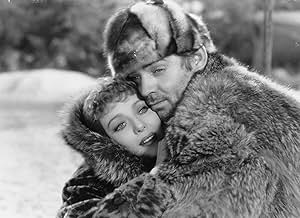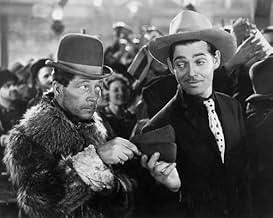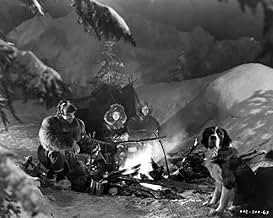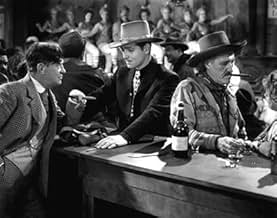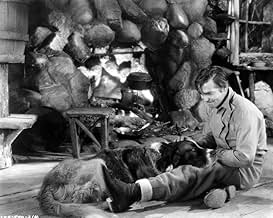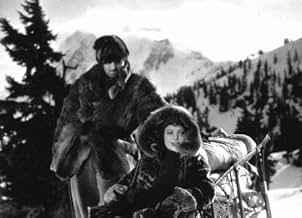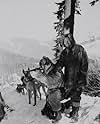IMDb RATING
6.8/10
2.8K
YOUR RATING
During the Klondike Gold Rush, a traveler purchases a dog to lead the way toward the treasure, but reconsiders his journey when he finds a stranded widow.During the Klondike Gold Rush, a traveler purchases a dog to lead the way toward the treasure, but reconsiders his journey when he finds a stranded widow.During the Klondike Gold Rush, a traveler purchases a dog to lead the way toward the treasure, but reconsiders his journey when he finds a stranded widow.
- Director
- Writers
- Stars
- Awards
- 1 win total
Thomas E. Jackson
- 'Tex' Rickard
- (as Tommy Jackson)
George MacQuarrie
- Mounted Policeman
- (as George McQuarrie)
C.E. Anderson
- Fourth Poker Player
- (uncredited)
Edwin Argus
- Dawson Townsman
- (uncredited)
William Arnold
- First Faro Player
- (uncredited)
- Director
- Writers
- All cast & crew
- Production, box office & more at IMDbPro
Featured reviews
Gable has it all for a short while: easy pickings gold nuggets, a gorgeous girlfriend he found in the wilderness, a half-wild soul mate lead dog and a bashful wisecracking partner. But, his grasp on all of these is slippery, as the plot develops. I don't fault Hollywood for departing so flagrantly from London's story, which too was just a yarn. I found this version much more entertaining and profound, despite the stereotypical boss-sidekick relationship between Gable and Jack Oakie.
Gable seems to represent sort of an ideal adventurous entrepreneur: a riverboat gambler at heart, who is willing to take big risks and to work for his fortune when necessary, but who tries to grab all he can and beat out the competition. The chief villain is a stereotypical pretentious cutthroat tycoon: the worst kind of capitalist. In contrast, Gable recognizes certain limits in gaining his fortune and honors his commitments to his partners, be they human or animal. Loretta's creed is yet more tempered: You will get what you want only if you deserve it. See the movie to find out how these various creeds interact to determine the outcome.
This is perhaps Gable's most enjoyable role, along with those in "Mutiny on the Bounty" and "Boom Town". As in most of his best roles, Gable comes across as rakish: part hero, part scoundrel, but never dull. Like Gable, Loretta is at her physical peak at this time, making for a very romantic-looking couple.
Gable seems to represent sort of an ideal adventurous entrepreneur: a riverboat gambler at heart, who is willing to take big risks and to work for his fortune when necessary, but who tries to grab all he can and beat out the competition. The chief villain is a stereotypical pretentious cutthroat tycoon: the worst kind of capitalist. In contrast, Gable recognizes certain limits in gaining his fortune and honors his commitments to his partners, be they human or animal. Loretta's creed is yet more tempered: You will get what you want only if you deserve it. See the movie to find out how these various creeds interact to determine the outcome.
This is perhaps Gable's most enjoyable role, along with those in "Mutiny on the Bounty" and "Boom Town". As in most of his best roles, Gable comes across as rakish: part hero, part scoundrel, but never dull. Like Gable, Loretta is at her physical peak at this time, making for a very romantic-looking couple.
Wiliam Wellman is the director at the helm of this version of Jack London's immensely popular novel. As an adventure, this movie offers a lot of fun because of the enormous appeal of its star, Clark Gable. He is a man's man. Mr. Gable projected such an aura about himself that he carried from film to film, making him one of the favorites of all audiences. The gold rush is presented as it should have been for the people that went in search of riches in the inhospitable confines of Alaska.
In this version, Loretta Young plays Claire Blake, the woman who conquered Jack Thornton's heart. The rumored affair between Ms. Young and Mr. Gable is fun to look at. What's real, and what not? It's up to the stars to know and for us, the viewers, to guess. Ms. Young and Mr. Gable were appealing players, as they prove in this film.
In other roles, Jack Oakie, Reginald Owen, Frank Conroy, and other old faces from films of the era make wonderful appearances. Above all, Buck, the great St. Bernard dog in the film is amazing. It's a joy to watch Mr. Gable's scenes with Buck as they compliment one another in that frigid background.
In this version, Loretta Young plays Claire Blake, the woman who conquered Jack Thornton's heart. The rumored affair between Ms. Young and Mr. Gable is fun to look at. What's real, and what not? It's up to the stars to know and for us, the viewers, to guess. Ms. Young and Mr. Gable were appealing players, as they prove in this film.
In other roles, Jack Oakie, Reginald Owen, Frank Conroy, and other old faces from films of the era make wonderful appearances. Above all, Buck, the great St. Bernard dog in the film is amazing. It's a joy to watch Mr. Gable's scenes with Buck as they compliment one another in that frigid background.
This is my first exposure to anything regarding THE CALL OF THE WILD. Meaning that I haven't read Jack London's original novel, never saw any of the earlier film versions, and did not see any of the later remakes. Even as a Charlton Heston fan I've so far avoided his 1972 edition because it's said to be pretty bad; even Heston begged his fans not to see it! But all that may soon change, as I enjoyed the 1935 version, starring Clark Gable and Loretta Young.
Gable is well cast as Jack Thornton, a rugged and adventurous type who travels the Yukon on a hunt for gold with the aid of his comical sidekick Shorty (Jack Oakie) and man's best friend, Buck the dog. In the midst of their quest they stumble upon a shaken woman (Young) whose husband has disappeared in the wilderness and may or may not be dead. Fearing the worst, Young joins the expedition and the expected romance with Gable gradually takes shape.
For me, one of the highlights of the picture was British actor Reginald Owen who scores high with his portrayal of a nasty rich man who's also competing with Gable for the loot. Never short on snobbish insults, and harboring a personal vendetta against Thornton's dog Buck, Owen is a delight in every scene he's in. The same cannot necessarily be said for Jack Oakie, however... as Shorty, his goofy shenanigans sometimes verge on the overbearing.
A nice mixture of adventure, villainy, romance, and some comedy that occasionally works, makes for a mostly good time. I was a little let down by the convenient ending. *** out of ****
Gable is well cast as Jack Thornton, a rugged and adventurous type who travels the Yukon on a hunt for gold with the aid of his comical sidekick Shorty (Jack Oakie) and man's best friend, Buck the dog. In the midst of their quest they stumble upon a shaken woman (Young) whose husband has disappeared in the wilderness and may or may not be dead. Fearing the worst, Young joins the expedition and the expected romance with Gable gradually takes shape.
For me, one of the highlights of the picture was British actor Reginald Owen who scores high with his portrayal of a nasty rich man who's also competing with Gable for the loot. Never short on snobbish insults, and harboring a personal vendetta against Thornton's dog Buck, Owen is a delight in every scene he's in. The same cannot necessarily be said for Jack Oakie, however... as Shorty, his goofy shenanigans sometimes verge on the overbearing.
A nice mixture of adventure, villainy, romance, and some comedy that occasionally works, makes for a mostly good time. I was a little let down by the convenient ending. *** out of ****
The beginning of Call of the Wild (a very loose adaptation of Jack London's novel of the same name) is made up of hard to decipher plot set up exposition which I was only able to get my head around until my third viewing; surely there could have been a more interesting and engaging way the film could have delivered all this information to the viewer. Likewise, a scene during the beginning of the film in which Jack Thornton (Gable) returns to his room only to find his love interest (and possible prostitute) Marie (Katherine deMille) having an affair with another man doesn't appear to have any effect on the rest of the plot. According to TCM originally Marie had an earlier scene but this was cut from the original print of the film. After this rather static opening, the film gets rolling and finds one of its emotional cores.
Call of the Wild is one of the best dog movies with its complex relationship and emotional bond between Gable and the Saint Bernard named Buck, one majestic looking beast. Buck is a dog that would be of no use to Jack yet is willing to pay $250 to save its life. The image Gable hugging the pooch tells more than words can; truly man's best friend.
Arguably the most powerful scene in the film is that of Buck trying to pull 1,000 pounds as the result of a bet. You couldn't ask for a more powerful and barbaric display of willpower knowing if he doesn't succeed his life will be taken. The dog in the film appears to be legitimately struggling regards the weight it is actually carrying in real life. Much of the scenes in Call of the Wild featuring dogs would never make it to screen today due to the unethical treatment of animals which is more than apparent on screen. Near the beginning of the film two dogs fight each other on screen and uncut which today would ether to edited to create the illusion of a fight or with horribly unconvincing CGI. Likewise, the general handling of the dogs and even the use of an actual rabbit as bait for dogs to hunt creates a gritty and brutal realism on screen which could not be replicated today.
Reginald Owen is the show stealer as Mr. Smith, the posh, sinister English gentleman with a sick vendetta against a dog; those ridiculous magnified eyes give him the look of a madman. Likewise, Jack Oakie as Shorty comes off to me as an uncowardly version of the Cowardly lion, even down to that laugh. Shorty was killed off in the original cut of the film, as evident from the foreshadowing of his dice turning up snake eyes after Gable throws them to him. The new ending in which Shorty and Jack are reunited prevents the film from being darker in vein like The Treasure of the Sierra Madre.
It took me a long time to get the appeal of Loretta Young but I gradually came to see her immense likeability, partially in due to those gazing, soulful eyes. In Call of the Wild her makeup is applied flawlessly despite being stuck in the freezing cold wilderness but she's still she's a tough cookie who can lecture Gable on a thing or two. I love a good man and woman alone in the wilderness film in which their chemistry fully shines through and the process of falling in love happens organically which in this instance may have been aided by Gable and Young's affair they had during the production which bore a child named Judy. In a moment of art imitating life Shorty even says; "You know I know a couple of people who used to fool around like that and they got children now".
I like this sub-genre of the northern western, a refreshing alternative to the mundanity I can often experience in traditional westerns. This is aided by the extensive use of location shooting present in Call of the Wild with those beautiful mountains, silhouetted trees and all that gleaming white snow - I don't believe there could be a better natural light reflector than the white stuff.
Call of the Wild is one of the best dog movies with its complex relationship and emotional bond between Gable and the Saint Bernard named Buck, one majestic looking beast. Buck is a dog that would be of no use to Jack yet is willing to pay $250 to save its life. The image Gable hugging the pooch tells more than words can; truly man's best friend.
Arguably the most powerful scene in the film is that of Buck trying to pull 1,000 pounds as the result of a bet. You couldn't ask for a more powerful and barbaric display of willpower knowing if he doesn't succeed his life will be taken. The dog in the film appears to be legitimately struggling regards the weight it is actually carrying in real life. Much of the scenes in Call of the Wild featuring dogs would never make it to screen today due to the unethical treatment of animals which is more than apparent on screen. Near the beginning of the film two dogs fight each other on screen and uncut which today would ether to edited to create the illusion of a fight or with horribly unconvincing CGI. Likewise, the general handling of the dogs and even the use of an actual rabbit as bait for dogs to hunt creates a gritty and brutal realism on screen which could not be replicated today.
Reginald Owen is the show stealer as Mr. Smith, the posh, sinister English gentleman with a sick vendetta against a dog; those ridiculous magnified eyes give him the look of a madman. Likewise, Jack Oakie as Shorty comes off to me as an uncowardly version of the Cowardly lion, even down to that laugh. Shorty was killed off in the original cut of the film, as evident from the foreshadowing of his dice turning up snake eyes after Gable throws them to him. The new ending in which Shorty and Jack are reunited prevents the film from being darker in vein like The Treasure of the Sierra Madre.
It took me a long time to get the appeal of Loretta Young but I gradually came to see her immense likeability, partially in due to those gazing, soulful eyes. In Call of the Wild her makeup is applied flawlessly despite being stuck in the freezing cold wilderness but she's still she's a tough cookie who can lecture Gable on a thing or two. I love a good man and woman alone in the wilderness film in which their chemistry fully shines through and the process of falling in love happens organically which in this instance may have been aided by Gable and Young's affair they had during the production which bore a child named Judy. In a moment of art imitating life Shorty even says; "You know I know a couple of people who used to fool around like that and they got children now".
I like this sub-genre of the northern western, a refreshing alternative to the mundanity I can often experience in traditional westerns. This is aided by the extensive use of location shooting present in Call of the Wild with those beautiful mountains, silhouetted trees and all that gleaming white snow - I don't believe there could be a better natural light reflector than the white stuff.
The last time Clark Gable got loaned out for a film was the year before and he won an Academy Award. This time Louis B. Mayer got a good price for him from Fox for Call of the Wild.
Fox also did something unusual in that the film was shot on location with the mountains of Washington state serving as the Canadian Rockies. Some really stunning cinematography is done for this film, especially in the river scenes. Too bad color was not in use back then.
Watching Gable, Loretta Young, and Jack Oakie on a raft pulling it to shore in what must have been freezing water reminded me so much of the stunts Gable did for The Misfits. Of course back then he had the youth and vim and vigor to do such things.
The film served as the meeting place for Gable and Young they carried on a torrid affair that resulted in Loretta Young giving birth. Back then it would have been a career death sentence for a star to give birth to an out of wedlock daughter, especially for the very Catholic Ms. Young. A whole elaborate charade was concocted with Loretta adopting her own daughter as a single mom.
No Oscars this time for Gable, but a good strong performance as a rugged prospector up in the Klondike during the gold rush. Of course being involved with Loretta sure helped in the love scenes. Young plays a woman apparently abandoned in the snow by her husband who's presumed dead.
Jack Oakie as Gable's sidekick and Reginald Owen as the English villain engaged in some claim jumping are the best two of the supporting actors. Of the human variety.
Then there's Buck, Gable's trusty St. Bernard who he rescues from Reginald Owen. In that rugged country good sled dogs can come in mighty handy and Buck sure proves his worth. Up there, they are indeed man's best friend.
Fox also did something unusual in that the film was shot on location with the mountains of Washington state serving as the Canadian Rockies. Some really stunning cinematography is done for this film, especially in the river scenes. Too bad color was not in use back then.
Watching Gable, Loretta Young, and Jack Oakie on a raft pulling it to shore in what must have been freezing water reminded me so much of the stunts Gable did for The Misfits. Of course back then he had the youth and vim and vigor to do such things.
The film served as the meeting place for Gable and Young they carried on a torrid affair that resulted in Loretta Young giving birth. Back then it would have been a career death sentence for a star to give birth to an out of wedlock daughter, especially for the very Catholic Ms. Young. A whole elaborate charade was concocted with Loretta adopting her own daughter as a single mom.
No Oscars this time for Gable, but a good strong performance as a rugged prospector up in the Klondike during the gold rush. Of course being involved with Loretta sure helped in the love scenes. Young plays a woman apparently abandoned in the snow by her husband who's presumed dead.
Jack Oakie as Gable's sidekick and Reginald Owen as the English villain engaged in some claim jumping are the best two of the supporting actors. Of the human variety.
Then there's Buck, Gable's trusty St. Bernard who he rescues from Reginald Owen. In that rugged country good sled dogs can come in mighty handy and Buck sure proves his worth. Up there, they are indeed man's best friend.
Did you know
- TriviaLike many films of the era, this production was originally slated to film in the Southern Sierra Nevada near Sonora. In fact, production had already begun when a warm front melted the snow and forced a hasty and expensive move to Washington state.
- GoofsWhy call this a goof? It's just a funny way of saying he'd knife someone.
- Quotes
Jack Thornton: Me? I'll take bourbon. It kills you slower, but a lot more pleasant like.
- Alternate versionsOriginally released at 95 minutes; later cut to 81 minutes for a re-issue. For many years only the cut re-issue version was available for television showings, and it is also the version released on DVD in 2006 as part of the Clark Gable Collection. The original length version remained unseen until it was released on blu-ray in 2013.
- ConnectionsFeatured in Ta mère ou moi ! (1991)
- How long is Call of the Wild?Powered by Alexa
Details
- Runtime
- 1h 35m(95 min)
- Color
- Sound mix
- Aspect ratio
- 1.37 : 1
Contribute to this page
Suggest an edit or add missing content


